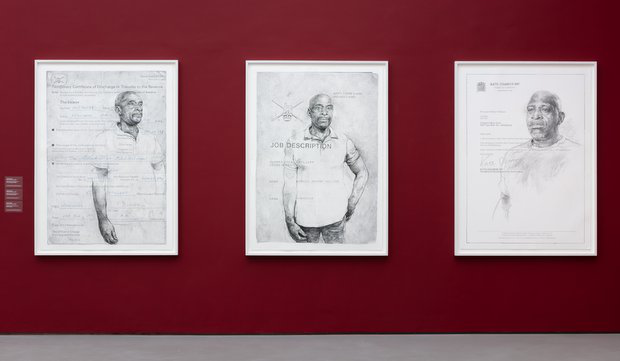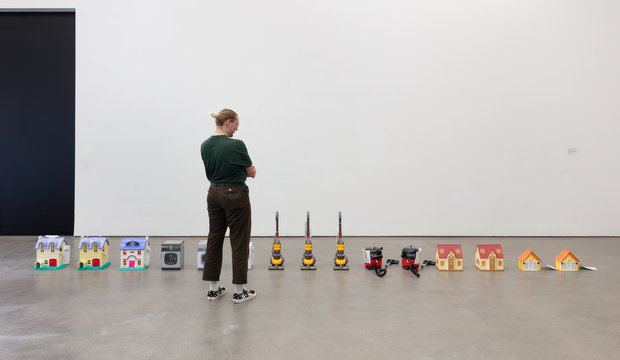Turner Prize 2023, Towner, Eastbourne, review
Jesse Darling's installation. Photograph: Angus Mill
Discrimination, mental health, razor wire and toy vacuum cleaners are all part of this year’s Turner Prize exhibition, which is being hosted by the excellent Towner on the South Coast in Eastbourne - a venue that’s made all the more inviting by the colourful Lothar Goetz mural on its facade.
Barbara Walker’s work is the strongest on show as she has drawn the documents members of the Windrush generation had to produce to remain in the UK even though they had been here for decades - a scandal that it’s important for us to remember. Each document is overlaid with a drawing of the individual to highlight how each person’s livelihood was reduced to a piece of paper. To celebrate these persons she’s also drawn them at a grand scale on the wall to celebrate them as individuals - not how they were dehumanised by the Windrush scandal.

Jesse Darling’s installation also has a sense of threat to it as we enter under a row of razor wire and through some bent metal barricades, before it turns more playful with a curved ladder that looks like it’s exploded out from the wall. The chaotic installation loosely hints at domestic living and borders and is clearly the most energetic, if not the most cohesive, of the four entrants.
Rory Pilgrim’s hour long film will also have visitors wondering what the narrative is but it builds over time as residents of Barking and Dagenham talk about how art and nature have helped them manage their mental health - told through the form of song, dance and interviews. It’s definitely a grower and by focusing on individuals outside of the arts and their amateur art and poetry, it resonates deeper.

Ghislaine Leung’s work feels like the weakest of the four with interesting ideas around cancelling noise with the use of a fountain and showcasing miniature houses and appliances from a toy library, but there’s no clear narrative and it falls flat.
The strength of the Turner Prize is having a diversity of artists that provoke discussion and this year’s entries definitely hit that target, with both Walker and Pilgrim likely to generate emotional reactions to their works.
Who will win? That’s the question most visitors will want to guess at and while we think the strength of Barbara Walker’s showing suggests she should win, we think Rory Pilgrim is the outsider whose work will win for standing out as being the most distant from what we tend to see at contemporary art exhibitions.
Second image - Barbara Walker's work, third image Ghislaine Leung's installation. Photography: Angus Mill.
Barbara Walker’s work is the strongest on show as she has drawn the documents members of the Windrush generation had to produce to remain in the UK even though they had been here for decades - a scandal that it’s important for us to remember. Each document is overlaid with a drawing of the individual to highlight how each person’s livelihood was reduced to a piece of paper. To celebrate these persons she’s also drawn them at a grand scale on the wall to celebrate them as individuals - not how they were dehumanised by the Windrush scandal.

Jesse Darling’s installation also has a sense of threat to it as we enter under a row of razor wire and through some bent metal barricades, before it turns more playful with a curved ladder that looks like it’s exploded out from the wall. The chaotic installation loosely hints at domestic living and borders and is clearly the most energetic, if not the most cohesive, of the four entrants.
Rory Pilgrim’s hour long film will also have visitors wondering what the narrative is but it builds over time as residents of Barking and Dagenham talk about how art and nature have helped them manage their mental health - told through the form of song, dance and interviews. It’s definitely a grower and by focusing on individuals outside of the arts and their amateur art and poetry, it resonates deeper.

Ghislaine Leung’s work feels like the weakest of the four with interesting ideas around cancelling noise with the use of a fountain and showcasing miniature houses and appliances from a toy library, but there’s no clear narrative and it falls flat.
The strength of the Turner Prize is having a diversity of artists that provoke discussion and this year’s entries definitely hit that target, with both Walker and Pilgrim likely to generate emotional reactions to their works.
Who will win? That’s the question most visitors will want to guess at and while we think the strength of Barbara Walker’s showing suggests she should win, we think Rory Pilgrim is the outsider whose work will win for standing out as being the most distant from what we tend to see at contemporary art exhibitions.
Second image - Barbara Walker's work, third image Ghislaine Leung's installation. Photography: Angus Mill.
TRY CULTURE WHISPER
Receive free tickets & insider tips to unlock the best of London — direct to your inbox
| What | Turner Prize 2023, Towner, Eastbourne, review |
| When |
28 Sep 23 – 14 Apr 24, 10:00 AM – 5:00 PM |
| Price | £0 |
| Website | Click here for more information |